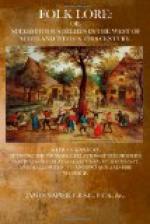An eclipse of the sun was looked on as an omen of coming calamity. This is a very ancient superstition, and remained with us to a very late date, if it is even yet extinct. In 1597, during an eclipse of the sun, it is stated by Calderwood that men and women thought the day of judgment was come. Many women swooned, the streets of Edinburgh was full of crying, and in fear some ran to the kirk to pray. I remember an eclipse about 1818, when about three parts of the sun was covered. The alarm in the village was very great, indoor work was suspended for the time, and in several families prayers were offered for protection, believing that it portended some awful calamity; but when it passed off there was a general feeling of relief.
Fishers on the West Coast believe that were they to set their nets so that in any way it would encroach upon the Sabbath, the herrings would leave the district. Two years ago I was told that herrings were very plentiful at one time at Lamlash, but some thoughtless person set his net on a Sabbath evening. He caught none, and the herrings left and never returned.
I know several persons who refuse to have their likeness taken lest it prove unlucky; and give as instances the cases of several of their friends who never had a day’s health after being photographed.
In addition to the many forms of superstition which we have been recalling, there were, and still are a great many superstitions connected with the phenomenon of dreaming, but as the notions in this series were very varied, differing very much in different localities, and everywhere subject less or more to the fancy of the interpreter, and as I believe that the notions and practices now in vogue in this connection are of comparatively recent origin, I will not enter upon the subject.
APPENDIX.
YULE, BELTANE, & HALLOWE’EN FESTIVALS:
Survivals of Ancient Sun and Fire Worship.
History and prehistoric investigations have shown quite clearly that prehistoric man worshipped the Sun, the giver and vivifier of all life, as the supreme God. To the sun they offered sacrifices, and at stated periods celebrated festivals in his honour; and at these festivals bread and wine and meat were partaken of, with observances very similar in many respects to the practices of the Jews during their religious feasts. But although the sun was the supreme deity, other objects were also worshipped as subordinate deities. These objects, however, were generally in some manner representative of sun attributes; for example, the Moon was worshipped as the spouse of the Sun, Venus as his page. The pleiades and other constellations, and single stars were also deified; the rainbow and the lightning were sun servants, the elements, the sun’s offspring. Many animals and trees were reverenced as representatives of sun attributes. Above all, fire was worshipped as the truest symbol of the sun upon earth, and all offerings and sacrifices in honour of the sun were presented through fire; thus sun and fire worship became identified.




